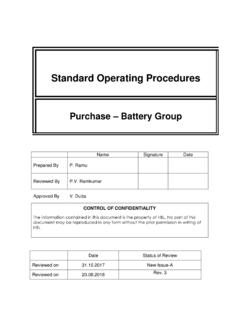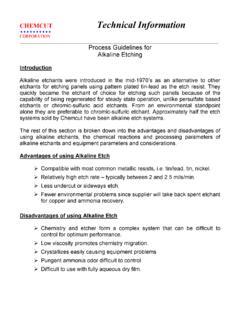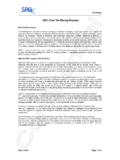Transcription of PURE LEAD TIN BATTERIES - HBL Power Systems Limited
1 pure LEAD TIN BATTERIESVRLA Monobloc BATTERIES for Standby applicationsTechnical ManualTM01 The Company4444 pure Lead-Tin (PLT) Technology444444 HBL Power Systems Limited is dedicated to providing engineered Power solutions around a number of technologies. It is one of a few battery and energy businesses in the world to offer the full range of battery many specialized battery technologies offered by HBL, reflecting its strengths, include:Nickel Cadmium (Pocket Plate, Fibre Plate, Sintered Plate)Silver Zinc (Primary & Secondary)Lithium (Thionyl Chloride & Iron di Sulphide)Valve Regulated Lead Acid (Flat plate AGM & Tubular Gel)The company has one of the highest levels of engineers to direct its work unique combination of technologies and talent pool gives us an opportunity to provide customers purpose made solutions for their application battery is a critical component of any Power supply system and has a significant impact on its performance and reliability. Today, there is a distinct preference for high-performance, compact and light weight Lead-Tin technology offers many advantages which include:High overall efficiencyHigh energy densityExcellent high rate performanceExcellent low temperature performanceLong float lifeHigh cycle lifeThe technology enables continuous manufacture of pure Lead Tin plates using automated assembly lines complete with sophisticated equipment and online quality by HBL , PLT redefines performance.
2 These BATTERIES employ pure Lead-Tin plate technology for high performance. The advantage of PLT technology is the plates can be produced at optimum thickness depending on the application. These Valve Regulated Lead Acid (VRLA) BATTERIES are designed using Absorbent Glass Mat (AGM) separators that render the BATTERIES spill-proof. Use of AGM separators in combination with self-resealing, pressure regulating valves and a starved electrolyte design enable recombination of gasses generated during normal operation. This eliminates the need for electrolyte BATTERIES are delivered fully charged and can be commissioned immediately without and spill-proof. This enables flexible mountingCompact and light weight for easy handlingWide operating temperature range (-40 C to +50 C)High energy density (gravimetric and volumetric)Good charge retention leading to long storage lifeLow internal resistance ensures quick rechargeExcellent high rate capability permits use of smaller capacity batteriesSuperior raw materials for good performance and lifeExcellent deep discharge recovery characteristicsUL recognized plastic componentsSuperior Features 02 PLT BATTERIES are the ideal choice for all applications requiring reliable back-up.
3 Typical applications includeTelecommunicationsFront Terminal BATTERIES for ETSI Telecom cabinetsRailway SignalingSolar PhotovoltaicDuty CycleEmergency LigthingPLT BATTERIES conforms to TEC No.: GR/BAT-01/03 March 2004, IEC 60896-21 & 22:2004 and certified by Intertek ETL Semco. 444444 ApplicationsSelf-resealing, pressure regulating valveImpact resistant ABS container and lidHigh conductivity copper alloy terminalsPlates with superior grids and active material High quality Absorbent Glass Mat separator ConstructionWhen a lead acid battery reaches the end of its life, the failure mode is positive grid corrosion. Grid corrosion reduces the available cross section of the grid which is required to carry current. While this reduced cross section is adequate to deliver low currents while carrying out capacity tests, it is not adequate to sustain high special pure Lead-Tin alloy minimizes positive grid corrosion. The cross-sections of the grids have also been designed so as to minimize the effect of alternative method of expressing battery life is the number of cycles that can be delivered by a battery at a specified discharge rate to a specified end voltage at an ambient temperature of 25 depth of discharge (DOD) is an important variable affecting the battery's cycle life expectancy (as shown in below).
4 It is important to optimize the charging regime of the battery for cycling applications in order to ensure full recharge before discharging the battery. Full recharge can be achieved by using an elevated voltage for charging. It is highly detrimental to subject an undercharged battery to cycling since this will cause premature battery LifeGraph 2 LifeFloat expected life of a battery, also known as its designed life, is influenced by the ambient temperature. Based on the Arrhenius Equation, which relates ambient temperature and the rate of positive-grid corrosion of the battery, it is estimated that the expected life of lead acid BATTERIES is reduced by 50% for every 8 to 10 C rise in the average ambient Float Application is defined based on the time interval between two successive discharges. The minimum time interval between two successive discharges must be more than 14 days and average interval may be 30 a float arrangement, the battery is kept connected across a charger which continually replenishes the drain in the battery caused due to self-discharge.
5 The charger also supplies Power to the load (like Electronic Switches, Control Circuits etc.,). The life of the battery, in this instance, is defined in calendar years at a standard temperature of 25 expected float life of BATTERIES at various average ambient temperatures, when floated at volts per cell, is shown in Graph 2 - Cycle Life Vs Depth of Discharge0204060801001204506007509001050 120013501500No. of cycles expected%DOD Graph 2 - Cycle life Vs Depth of DischargeGraph 1 - Float life Vs Average temperature0246810121416202530354045 Average ambient temperature ( C)Floatlifeexpected(years) Graph 1 - Float life Vs Average temperature03No current limit is required during constant voltage charging. However, the charger should be capable of giving at least A (where C is the capacity of battery at 20 hr rate of discharge to end per cell).2020 The charger should automatically sense the current drawn by the battery and switch over to the float mode when the battery is fully charged.
6 This switch-over from Boost to Float should occur when the charge current drops to a numerical value equal to 3% of the rated capacity of the battery. The charger automatically switches to Boost mode from Float mode when the battery draws a charge current of minimum 5% of the numerical value of the rated capacity of the battery. The charger should provide temperature compensation (as shown in ) to ensure optimum charging of the battery. The charger should also have an AC voltage ripple of <3% 3 ChargingConstant voltage charging is the most preferred charging method for these STAND BY applications, the charger must be set at the following voltages. Boost: V per cell ( , For 12V battery, Boost @ 6 X = )Float: V per cell ( , For 12V battery, Boost @ 6 X = )For cyclic applications, where the time available for re-charging is Limited , rapid charging can be carried out at the boost voltage specified : V per cell ( , For 12V battery, Boost @ 6 X = )Graph 3 - Temperature temperature ( C)FloatvoltageeperCll(volts) 04 Fast chargingPLT BATTERIES can accept a high charge current compared to other technologies because of having a low internal resistance.
7 The maximum current limit can be as much as 1C, equivalent to rated capacity of battery. A typical charge characteristics is shown as Characteristics With Different Current LimitsCurrent Limit ( X times Rated capacity)Recharge Time (Hrs) SOC100% SOC80% SOC020406080100120-40-30-20-100102030405 0 Temperature ( C)%CapacityAvailableThese BATTERIES can be used for applications with back-up duration of as short as 5 minutes (high rate discharge) to as long as 120 hours (low rate discharge). Discharge graphs (and ) at various rates of discharge for these BATTERIES are given below:Graph 5 Graph 6 Capacity and Discharge PerformanceGraph 4 PLT BATTERIES are rated at the 20hr rate of discharge to end V per cell at 25 C. Discharge currents available at 25 C from these BATTERIES for different time periods and to different end voltages is given in this BATTERIES are capable of performing between -40 C and +50 C. The performance of the battery will however be reduced at low temperatures (see ).
8 At higher temperatures, the performance will be enhanced, but the life of battery is 6 - Voltage Vs Time 024681012141101001000 Time (Hrs)Voltageperbloc(volts)C - 120Hr rateC - 80Hr RateC - 20Hr RateC - 8Hr RateC - 5Hr RateGraph 5 - Voltage Vs Time 024681012141101001000 Time (minutes)Voltageperbloc(volts)C-3 HrC-1 Hr Hr 05 Storage Table lose capacity when not in use, a phenomenon termed as self-discharge. The use of pure raw materials decreases the rate of self-discharge and enhances storage life. Loss of capacity during storage is to be compensated for by giving a freshening charge to the battery. In case the BATTERIES are stored for very long periods or at high temperatures without giving a freshening charge, there will be an irreversible sulphation leading to permanent loss in BATTERIES can be stored for a maximum period of one year at 25 C with open circuit voltage (OCV) monitoring every 4 months. If the OCV falls to V per cell, the battery should be given a freshening charge at for 12hrs.
9 In cases where the ambient temperature is more than 25 C, OCV monitoring should be done at more frequent intervals as shown in Table 1 Temperature ( C) Monitoring Frequency (months) < 20 6 20 29 4 30 35 3 36 40 2 41 50 1 Graph 4 - Capacity available at different temperatures(% of rated 10 hr capacity)Graph 5 - Voltage Vs TimeGraph 6 - Voltage Vs TimeoNominal capacity is at 20 hour rate of discharge to vpc at 25 C06 Range of 12V Monoblocs Model Capacity (Ah) Dimensions (mm) (Kgs) L W H PLT 14-1214175 85 130 5 PLT 17-1217181 76 168 6 PLT 20-1220163 142 147 9 PLT 25-1225249 97 151 10 PLT 32-1232163 142 200 12 PLT 40-1240249 97 201 13 PLT 52-1252220 121 260 19 PLT 70-1270330 168 176 23 PLT 83-1283286 268 182 32 PLT 110-12 110410 175 225 36 PLT 160-12 160525 220 225 56 Range of 6V Monoblocs Model Capacity (Ah) Dimensions (mm) (Kgs)
10 L W H PLT 120-6 120205 197 235 23 PLT 140-6 140205 197 235 25 PLT 75-12 FT 7549011022524 PLT 100-12 FT 10051011024032 PLT 110-12 FT 11055812522838 Front Terminal Monoblocs Range of 2V Monoblocs Model Capacity (Ah) Dimensions (mm) (Kgs) L W H PLT 350-2350 205 197 235 Constant Current Performance at 25 C 07 End Voltage VPCD ischarge Current in AmperesModel510152030451234567891020 MinutesHoursPLT Model510152030451234567891020 PLT 75-12 FT318 198 151 115 88 65 52 PLT 100-12 FT424 265 201 153 118 87 70 PLT 110-12 FT466 291 221 168 129 96 77 MinutesHours Model510152030451234567891020 PLT 75-12 FT315 196 149 114 87 65 52 PLT 100-12 FT420 262 199 152 116 86 69 PLT 110-12 FT 462 288 219 167 128 95 76 HoursMinutesEnd Voltage VPCD ischarge Current in AmperesModel510152030451234567891020 MinutesHoursPLT Model510152030451234567891020 PLT 75-12 FT306 191 145 110 85 63 50 PLT 100-12 FT408 254 193 147 113 84 67









